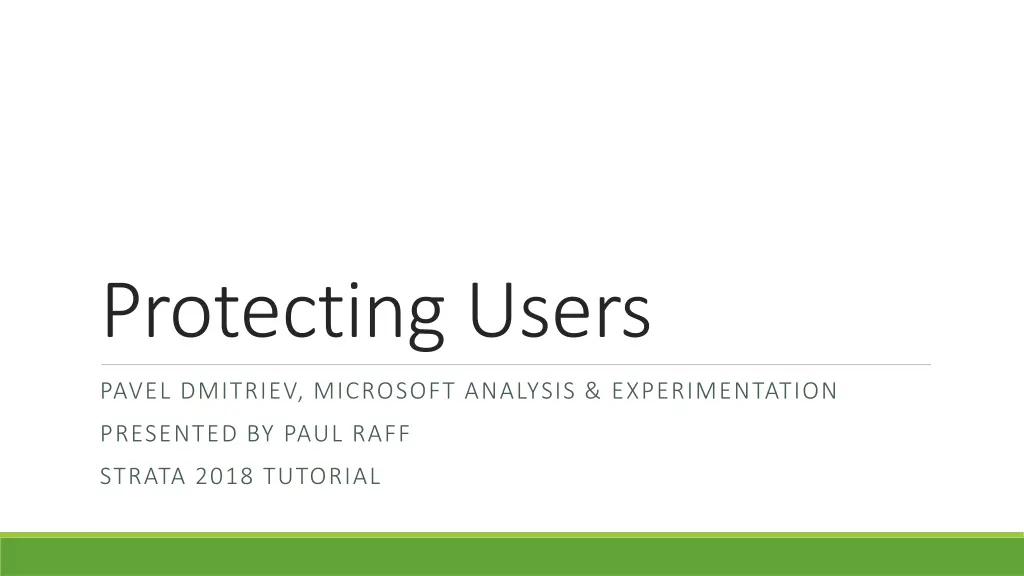
Fast Experimentation System for User Protection
"Learn how to implement a fast experimentation system to protect users from potential harm. Discover strategies for auto-detecting and shutting down bad experiments, starting small, and preventing interactions between concurrent experiments."
Download Presentation

Please find below an Image/Link to download the presentation.
The content on the website is provided AS IS for your information and personal use only. It may not be sold, licensed, or shared on other websites without obtaining consent from the author. If you encounter any issues during the download, it is possible that the publisher has removed the file from their server.
You are allowed to download the files provided on this website for personal or commercial use, subject to the condition that they are used lawfully. All files are the property of their respective owners.
The content on the website is provided AS IS for your information and personal use only. It may not be sold, licensed, or shared on other websites without obtaining consent from the author.
E N D
Presentation Transcript
Protecting Users PAVEL DMITRIEV, MICROSOFT ANALYSIS & EXPERIMENTATION PRESENTED BY PAUL RAFF STRATA 2018 TUTORIAL
The Challenge As more and more experiments are run, possibility of user harm increases Less manual monitoring of experiments Buggy feature or a bad idea may make it to real users Interactions are possible between concurrently running experiments Experimentation system itself may have issues and can hurt users (link) If you have to kiss a lot of frogs to find a prince, find more frogs and kiss them faster and faster -- Mike Moran, Do it Wrong Quickly Need to minimize harm to users!
Fast Auto-Detection and Shutdown of Bad Experiments Experimentation system needs to Automatically analyze scorecards Detect bad experiments Send alerts to experimenters In cases of extreme badness, shut down the experiment automatically The challenge is doing it fast (seconds to minutes) Requires a real-time data pipeline Data in the beginning of experiment may be noisy Small amount of data Easily dominated by a few very active users or bots Aggregating from event-level to user-level helps reduce false positives
Starting Small Start with a small percentage, e.g. 0.5% This should be enough to detect outrageously bad experiments Once verified that things look Ok, can [automatically] ramp up Run experiment with partial exposure E.g. only on 1 out of 10 queries in the treatment actually gets served treatment experience Once verified that things look Ok, ramp up the exposure to 100% The advantage is that no single user can be stuck in a bad experience for a long time The disadvantage is inconsistent user experience, and dilution to user-level metrics
Prevent and Detect Interactions Interaction happens if an effect of exposing users to several experiments at the same time is not the same as adding up the effects of individual experiments The whole is greater than the sum of its parts -Aristotle I told about the whole being greater than the sum of its parts. It's that way with people, too, he said, only with people it's sometimes that the whole is less than the sum of the parts. -Wendelin Van Draanen, Flipped
Prevent and Detect Interactions Interaction happens if an effect of exposing users to several experiments at the same time is not the same as adding up the effects of individual experiments Example (antagonistic): E1 changes font to blue, E2 changes background color to blue Example (synergetic): E1, ,EN make page header more convenient on page1, ,pageN Our experience is that, when prevention setup is in place, interactions are rare About a dozen interactions per year in Bing, with over 10,000 experiments run
Interaction Prevention When suspecting an interaction: Run experiments sequentially (slow) Run non-overlapping experiments (two experiments need to use the same hash seed, and get assigned to different portions of the hash space) E1 E2 E1 hash1 space hash3 space f(hash1,uid1) f(hash3,uid1) E2 f(hash2,uid1) hash2 space user (uid1) user (uid1) Overlapping Experiments Non-overlapping Experiments
Interaction Detection Given two overlapping experiments: E1(T1,C1), E2(T2,C2) and a metric M, there s an interaction if the results for M in E1 are stat. sig. different in the segment of users who are in T2 compared to the segment of users who are in C2. Note: need to run it for all pairs of overlapping experiments. Complexity= O(#metrics*#experiments^2) Need to control for type I errors (e.g. Bonferroni Correction) T2 T1 C1 (T1-C1 | T2) =?= (T1-C1 | C2) C2 All E1 Users
Summary Automated methods to protect users are required as the number of experiments ramps-up Experimentation system should not just report out the results, but should auto-analyze them and take action: Send alerts Auto-shutdown bad experiments Start small and ramp-up Prevent and detect interactions
